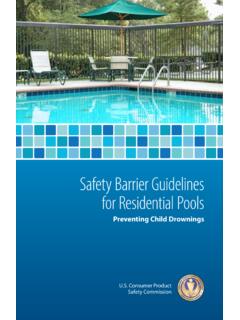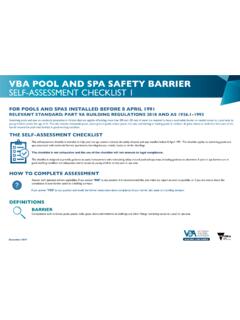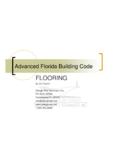Transcription of CHAPTER 6 Houseflies - World Health Organization
1 302 CHAPTER 6 HOUSEFLIES. CHAPTER 6. House ies Carriers of diarrhoeal diseases and skin and eye infections The common house y, Musca domestica, lives in close association with people all over the World (Fig. ). The insects feed on human foodstuffs and wastes where they can pick up and transport various disease agents. In addition to the house y, a number of other y species have adapted to life in human settlements, where they present similar problems. In warmer climates, the lth y, M. sorbens is of particu- lar interest in this regard. It is closely related to the house y and considered important in the spread of eye infections. Blow ies (Calliphoridae) and other ies have been associated with the transmission of enteric infections.
2 Biology Life cycle There are four distinct stages in the life of a y: egg, larva or maggot, pupa and adult (Fig. ). Depending on the temperature, it takes from 6 to 42 days for the egg to develop into the adult y. The length of life is usually 2 3 weeks but in cooler conditions it may be as long as three months. Eggs are usually laid in masses on organic material such as manure and garbage. Hatching occurs within a few hours. The young larvae burrow into the breeding material; they must obtain oxygen from the atmosphere and can, there- fore, survive only where suf cient fresh air is available. When the breeding me- dium is very wet they can live on its surface only, whereas in drier materials they may penetrate to a depth of several centimetres.
3 The larvae of most species are slender, white, legless maggots that develop rapidly, passing through three instars. The time required for development varies from a minimum of three days to several weeks, depending on the species as well as the temperature and type and quantity of food available. After the feeding stage is completed the larvae migrate to a drier place and burrow into the soil or hide under objects offering protection. They form a capsule-like case, the puparium, within which the transformation from larva to adult takes place. This usually takes 2 10 days, at the end of which the y pushes open the top of the case and works its way out and up to the surface. Soon after emergence the y spreads its wings and the body dries and hardens.
4 The adult y is grey, 6 9 mm long and has four dark stripes running lengthwise on the back. A few days elapse before the adult is capable of reproduction. Under natural conditions an adult female rarely lays eggs more than ve times, and seldom lays more than 120 130 eggs on each occasion. Food Both male and female ies feed on all kinds of human food, garbage and excreta, including sweat, and on animal dung. Under natural conditions ies seek a wide BIOLOGY 303. Fig. The house y (Musca domestica). (by courtesy of the Natural History Museum, London). Fig. The life cycle of the y ( WHO). 304 CHAPTER 6 HOUSEFLIES. variety of food substances. Because of the structure of their mouthparts, food must be either in the liquid state or readily soluble in the salivary gland secretions or in the crop.
5 Liquid food is sucked up and solid food is wetted with saliva, to be dissolved before ingestion. Water is an essential part of a y's diet and ies do not ordinarily live more than 48 hours without access to it. Other common sources of food are milk, sugar, syrup, blood, meat broth and many other materials found in human settlements. The ies evidently need to feed at least two or three times a day. Breeding sites Female ies deposit their eggs on decayed, fermenting or rotting organic material of either animal or vegetable origin. Unlike blow ies and esh ies, house ies rarely breed in meat or carrion. Dung Heaps of accumulated animal faeces are among the most important breeding sites for house ies.
6 The suitability of dung for breeding depends on its moisture (not too wet), texture (not too solid) and freshness (normally within a week after deposition). Garbage and waste from food processing Garbage provides the main medium for breeding (Fig. ). It includes waste associated with the preparation, cooking and serving of food at home and in public places, and with the handling, storage and sale of food, including fruits and vegetables, in markets. Organic manure Fields that are heavily manured with organic matter such as dung, excrement, garbage and sh-meal may provide suitable breeding places for ies. Fig. Garbage is the main medium for y breeding in urban areas. BIOLOGY 305.
7 Sewage House ies also breed in sewage sludge and solid organic waste in open drains, cesspools (underground pools for household sewage) and cesspits. Accumulated plant materials Piles of decaying grass clippings, compost heaps and other accumulations of rotting vegetable matter serve as good breeding places for ies. Ecology of adult ies An understanding of the ecology of ies helps to explain their role as carriers of disease and allows the planning of control measures. Adult ies are mainly active during the day, when they feed and mate. At night they normally rest, although they adapt to some extent to arti cial light. Resting places During the daytime, when not actively feeding, ies may be found resting on oors, walls, ceilings and other interior surfaces as well as outdoors on the ground , fences, walls, steps, simple pit latrines, garbage cans, clothes lines, grasses and weeds.
8 At night, ies are normally inactive. Their favourite resting places at this time are ceilings and other overhead structures. When temperatures remain high during the night, house ies frequently rest out of doors on fences, clothes lines, electric wires, cords, weeds, grasses, hedges, bushes and trees. These resting places are generally near favoured daytime feeding and breeding areas and sheltered from the wind. They are usually above ground level, but rarely more than ve metres high. Fluctuations in y numbers Fly numbers in a given locality vary with the availability of breeding places, sunshine hours, temperature and humidity. Fly densities are highest at mean temperatures of 20 25 C; they decrease at temperatures above and below this range and become undetectable at temperatures above 45 C and below 10 C.
9 At very low temperatures, the species can stay alive in a dormant state in the adult or pupal stage. Behaviour and distribution During the day, ies are mainly gathered on or around feeding and breeding places, where mating and resting also take place (Fig. ). Their distribution is greatly in uenced by their reactions to light, temperature, humidity, and surface colour and texture. The preferred temperature for resting is between 35 C and 40 C. Oviposition, mating, feeding and ying all stop at temperatures below 15 C. Flies are most active at low air humidities. At high temperatures ( above 20 C), most house ies spend the time outdoors or in covered areas near the open air. 306 CHAPTER 6 HOUSEFLIES.
10 Fig. Food market. During the day adult ies can be found in large numbers on food tables, garbage and the ground . When not eating, ies rest on horizontal surfaces and on hanging wires and vertically suspended articles and ceilings indoors, especially at night. A detailed study of local resting places is essential for successful control. Public Health importance Nuisance In large numbers ies can be an important nuisance by disturbing people during work and at leisure. Flies soil the inside and outside of houses with their faeces. They can also have a negative psychological impact because their presence is considered a sign of unhygienic conditions. Diseases Flies can spread diseases because they feed freely on human food and lthy matter alike.














